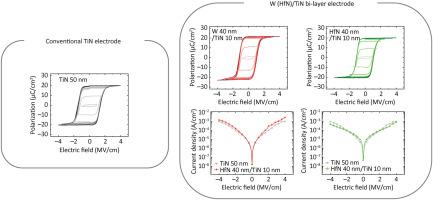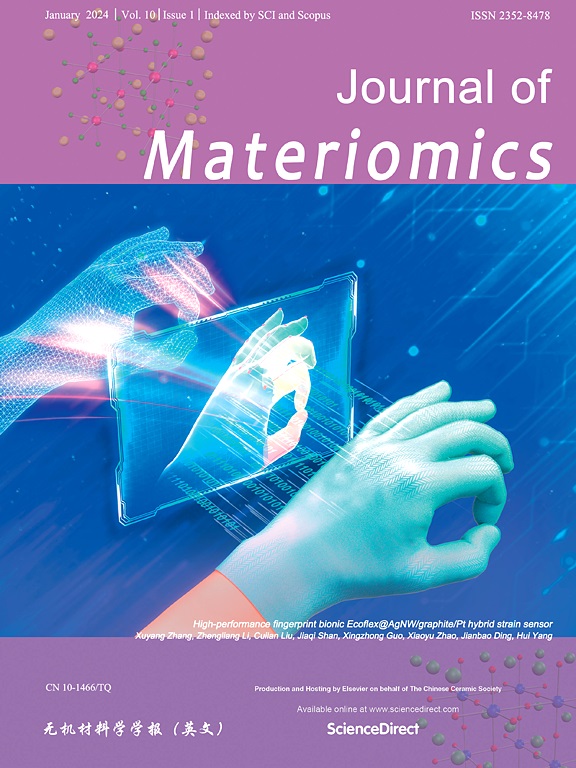Enhancing ferroelectric properties of Hf0.5Zr0.5O2 thin films using the HfN/TiN and W/TiN bi-layer bottom electrodes
IF 9.6
1区 材料科学
Q1 CHEMISTRY, PHYSICAL
引用次数: 0
Abstract
This study clarifies the influence of single-layer (TiN, HfN, W) and bi-layer (HfN/TiN, W/TiN) bottom electrodes (BEs) on the ferroelectric performance and reliability of the 10-nm-thick Hf0.5Zr0.5O2 (HZO) thin films. A smaller thermal expansion coefficient in HfN or W imposes higher in-plane tensile stress on the HZO thin films, facilitating the polar orthorhombic (o-) phase fraction and enhancing remanent polarization (Pr). However, thicker interfacial layers formed when HfN or W single-layer BE and HZO contacted directly, leading to excessive leakage current and degraded ferroelectric performance. These excessive interfacial layers were effectively suppressed by inserting a thin (5 nm–20 nm) TiN layer on the HfN or W BEs. As a result, the HZO thin films on the HfN/TiN and W/TiN bi-layer BEs decrease the HZO grain size, facilitating the o-phase formation (increasing Pr) and lowering the film's coercive field. However, the higher surface roughness of the W/TiN bi-layer BEs induced excessive leakage current and reliability degradation. In contrast, the HfN BEs with a 10- or 20-nm-thick upper TiN layer lower the surface roughness of the BEs, thereby eliminating the adverse effects. As a result, the HfN 40 nm/TiN 10 nm/HZO/TiN stack exhibited enhanced ferroelectric performance up to 109 switching cycles with a lower cycling field of 2.7 MV/cm than the TiN 50 nm/HZO/TiN stack with a cycling field of 3.7 MV/cm.


采用HfN/TiN和W/TiN双层底电极增强Hf0.5Zr0.5O2薄膜的铁电性能
本研究阐明了单层(TiN, HfN, W)和双层(HfN/TiN, W/TiN)底电极(BEs)对10nm厚Hf0.5Zr0.5O2 (HZO)薄膜铁电性能和可靠性的影响。HfN或W中较小的热膨胀系数会对HZO薄膜施加较大的面内拉伸应力,有利于极性正交相分数(o-)和残余极化(Pr)的形成。而HfN或W单层BE与HZO直接接触会形成较厚的界面层,导致漏电流过大,铁电性能下降。通过在HfN或wbe上插入薄的(5 nm至20 nm) TiN层,可以有效地抑制这些过量的界面层。结果表明,HfN/TiN和W/TiN双层BEs上的HZO薄膜减小了HZO晶粒尺寸,促进了o相的形成(Pr增大),降低了薄膜的矫顽场。然而,高表面粗糙度的W/TiN双层BEs会导致过大的漏电流和可靠性下降。相比之下,具有10或20 nm厚TiN层的HfN BEs降低了BEs的表面粗糙度,从而消除了不利影响。结果表明,与循环场为3.7 MV/cm的TiN 50 nm/HZO/TiN相比,HfN 40 nm/TiN 10 nm/HZO/TiN堆叠的铁电性能提高了109个开关周期,循环场为2.7 MV/cm。
本文章由计算机程序翻译,如有差异,请以英文原文为准。
求助全文
约1分钟内获得全文
求助全文
来源期刊

Journal of Materiomics
Materials Science-Metals and Alloys
CiteScore
14.30
自引率
6.40%
发文量
331
审稿时长
37 days
期刊介绍:
The Journal of Materiomics is a peer-reviewed open-access journal that aims to serve as a forum for the continuous dissemination of research within the field of materials science. It particularly emphasizes systematic studies on the relationships between composition, processing, structure, property, and performance of advanced materials. The journal is supported by the Chinese Ceramic Society and is indexed in SCIE and Scopus. It is commonly referred to as J Materiomics.
 求助内容:
求助内容: 应助结果提醒方式:
应助结果提醒方式:


